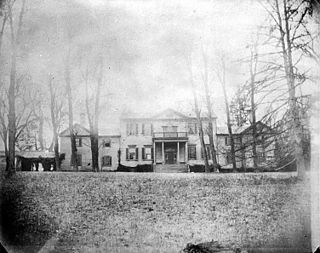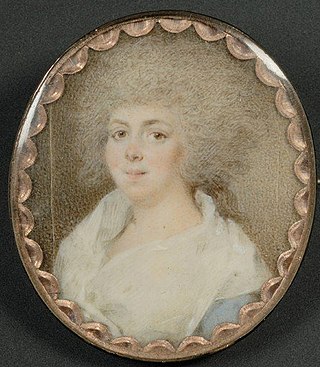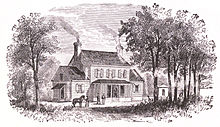
William Fitzhugh was an American planter, legislator and patriot during the American Revolutionary War who served as a delegate to the Continental Congress for Virginia in 1779, as well as many terms in the House of Burgesses and both houses of the Virginia General Assembly following the Commonwealth's formation. His Stafford County home, Chatham Manor, is on the National Register for Historic Places and serves as the National Park Service Headquarters for the Fredericksburg and Spotsylvania National Military Park.

William Henry Fitzhugh Lee, known as Rooney Lee or W. H. F. Lee, was the second son of General Robert E. Lee and Mary Anna Custis. He was a planter, a Confederate cavalry General in the American Civil War, and later a Democratic Congressman from Virginia.

Arlington House is the historic family home of George Washington Parke Custis, the ward of his grandmother Martha Dandridge Custis Washington and her second husband, George Washington, an American Revolutionary hero, one of the founding fathers of the United States, and its first president. Custis built Arlington House to be a memorial to his guardian. His own father John Parke Custis named him after his future guardian, George Washington, and had named his estate, "Mount Washington."

George Washington Parke Custis was an American plantation owner, antiquarian, author, and playwright. His father John Parke Custis was a stepson of George Washington. He and his sister Eleanor grew up at Mount Vernon and in the Washington presidential household.

Mary Anna Randolph Custis Lee was the wife of the Confederate general Robert E. Lee and the last private owner of Arlington Estate. She was the daughter of George Washington Parke Custis who was the grandson of Martha Washington, the wife of George Washington. Lee was a highly educated woman, who edited and published her father's writings after his death.

Eleanor Parke Custis Lewis, known as "Nelly", was a granddaughter of Martha Washington and a step-granddaughter of George Washington.

Mary Lee "Molly" Fitzhugh Custis was an Episcopal lay leader in Alexandria County in present-day Arlington County, Virginia. She was the mother of Mary Anna Randolph Custis, who was the wife of Robert E. Lee. In the early 1820s, Molly Custis helped form a coalition of women who sought to abolish slavery.

Daniel Parke Custis was an American planter and politician who was the first husband of Martha Dandridge. After his death, his widow, Martha Dandridge Custis married George Washington, who later became the first president of the United States.

Colonel John Custis IV was an American planter, politician, government official and military officer who sat in the House of Burgesses from 1705 to 1706 and 1718 to 1719, representing respectively Northampton County and later the College of William & Mary. A prominent member of the Custis family of Virginia, he utilized his extensive landholdings to support a career in horticulture and gardening.

John Parke Custis was an American planter and politician, only son of Martha Washington before her marriage to George Washington. He is now known for his progeny, especially those raised by President Washington.

Robert Edward Lee Jr. was the sixth of seven children of Confederate General Robert E. Lee and Mary Anna Randolph Custis. He became a soldier during the American Civil War, and later was a planter, businessman, and author.
Frances Jones Dandridge was the mother of Martha Washington, the first First Lady of the United States. She was born in New Kent County, Virginia. Her father Orlando Jones and maternal grandfather Colonel Gideon Macon served on the House of Burgesses in Colonial Virginia. Her parents were prosperous Virginian landowners.

Ravensworth was an 18th-century plantation house near Annandale in Fairfax County, Virginia. Ravensworth was the Northern Virginia residence of William Fitzhugh, William Henry Fitzhugh, Mary Lee Fitzhugh Custis, William Henry Fitzhugh Lee and George Washington Custis Lee. It was built in 1796.

Chestnut Grove was an 18th-century plantation house on the Pamunkey River near New Kent Court House in New Kent County, Virginia, United States. Chestnut Grove is best known as the birthplace of Martha Washington, wife of George Washington, and the first First Lady of the United States. Martha Washington was born in the east room of the mansion.

Martha Parke Custis Peter was a granddaughter of Martha Dandridge Washington and a step-granddaughter of George Washington.

Eleanor Calvert Custis Stuart, born Eleanor Calvert, was a prominent member of the wealthy Calvert family of Maryland. Upon her marriage to John Parke Custis, she became the daughter-in-law of Martha Dandridge Custis Washington and the step-daughter-in-law of George Washington. Her portrait hangs today at Mount Airy Mansion in Rosaryville State Park, Maryland.

Rosalie Stier Calvert was a plantation owner and correspondent in nineteenth century Maryland. A collection of her letters, titled Mistress of Riversdale, The Plantation Letters of Rosalie Stier Calvert, was published by the Johns Hopkins University Press in 1991. The letters range in date from 1795 to 1821, and illuminate the life of Calvert's plantation household, including the events leading up to and during the War of 1812.

Mildred Childe Lee was an American society hostess and the youngest child of Robert E. Lee and Mary Anna Custis Lee. She was the last member of the Lee family to be born at Arlington Plantation and had a privileged upbringing typical of members of the planter class, attending boarding schools in Winchester, Virginia, and Raleigh, North Carolina. A favorite of her father's, she was doted upon and given the nickname "Precious Life", often being referred to by this nickname in family letters. During the American Civil War, she sewed clothing for soldiers of the Confederate States Army and volunteered as a nurse in Confederate hospitals. Lee never married or had children, instead devoting her time to caring for her parents in their later years. After her father's death, she assisted her brother, George Washington Custis Lee, as hostess while he served as president of Washington College.

Maria Carter Syphax, otherwise spelled Mariah, was the matriarch of the Syphax family, a prominent family of African Americans in the greater Washington, D.C., area who became civic leaders, civil servants, and educators. She was born into slavery as Maria Carter, daughter of an enslaved woman and George Washington Parke Custis, a grandson of Martha Washington through her first marriage. Syphax was thus a great-granddaughter of First Lady Martha Washington.

Caroline Branham (1764–1843) was an enslaved housemaid and seamstress of George and Martha Washington. She was married to Washington's hired groomsman Peter Hardiman, whose slaveholder was David Stuart. Branham gave birth to nine children, seven with Hardiman. Her son, Austin (1798-1879), and her ninth child, Lucy, are believed to have been a child of the plantation; the boy's and girl's father was George Washington Parke Custis. Branham served the Washington family and their many visitors, ensuring they resided comfortably.























